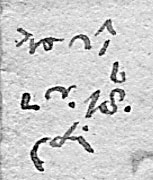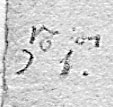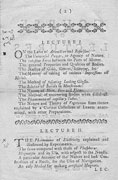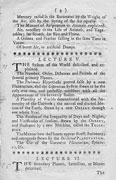Benjamin Martin: shorthand and the syllabus

The images shown here come from an undated single-sheet syllabus for 14 lectures on natural philosophy by Benjamin Martin, a scientific lecturer and instrument maker who settled in London in the mid-1750s. The syllabus was donated to the Museum of the History of Science, Oxford by John R. Millburn in 2004.
As discussed in relation to the dating, the sheet has two small groups of (probably related) marginalia. One group is in ink, the other in pencil. The ink annotations consist of what appears to be shorthand against the heading of lecture I, as well as small crosses against lectures I–III. (I’ve tentatively suggested one explanation for the crosses towards the end of the article.) Pencil is used for a series of numbers against lectures II–VIII, including a more extended annotation at lecture VI, which appears to be a combination of shorthand and a number.

The shorthand therefore appears in both ink and pencil. What do these two brief instances say? Do they refer to the dates and months (and perhaps also the year) in which the lectures took place? To fit with the sequence of other dates, lecture I should be February 18th (and it does appear to contain an 18 towards the end of the second line), while lecture VI would be March 1st (it likewise appears to contain a 1 at the beginning of the second group of characters). It is also possible that the lecture I annotation states where Martin lectured.
The problem in transcribing the shorthand is not only that there is so little of it to analyse, but that there was such a multiplicity of competing systems available in the mid-18th century.
One of the better-known 18th-century systems was devised by John Byrom; although only published in 1767, there were numerous users before then. Timothy Underhill, who has studied Byrom’s shorthand (“John Byrom (1692-1763): sources & shorthand”, Cambridge Ph.D., 2001), has seen these marginalia and detected some resemblances to Byrom’s system. But although there are certain correspondences in the character outlines, there are also signficant divergences. More tellingly, it is not possible to make meaningful sense of the few lines available using the rules of Byrom’s method, and in any case the outlines resemble those used in several shorthand systems of the mid-eighteenth century (and earlier) for a variety of letters, suffixes and prefixes.
Underhill concludes with the dispiriting but doubtless realistic thought that “There is also the (strong) possibility that the shorthand is partly or entirely personal to the writer – that was not unusual (and we all have our own personal note-taking quirks)” (personal communication). If this gives little ground for optimism that the text will ever be deciphered, the possibility nevertheless does remain: “But it is clearly a shorthand as far as I am concerned – presumably for space- or time-saving rather than secrecy”.
Any comments, suggestions or actual decipherings will therefore be much appreciated; please contact Stephen Johnston.
Acknowledgements. Thanks to Dorothy Roberts for pointers to shorthand sources and to Michael Powell of Chetham’s Library for putting me in contact with Timothy Underhill, who generously provided detailed notes on the shorthand text.

